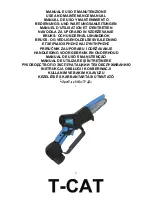
14
General rule for band saw blade speed: The
harder the material being cut, the slower the
blade speed.
A minimum of three teeth should be on the work
piece at all times for proper cutting. The blade and
workpiece can be damaged if the teeth are so far
apart that they straddle the workpiece.
For very high production on cutting of special
materials, or to work hard-to-cut materials such as
stainless steel, tool steel, or titanium, ask your
industrial distributor for more specific blade
recommendations. Also, the supplier who provides
the workpiece material should be prepared to
provide specific instructions regarding the best
blade (and coolant or cutting fluid, if needed) for the
material and shape supplied.
Use of a cutting oil is recommended when cutting at
higher blade speeds.
8.2
Blade break-in
New blades are very sharp and therefore have a
tooth geometry which is easily damaged if a careful
break-in procedure is not followed. Consult the
blade manufacturer’s literature for break-in of
specific blades on specific materials. However, the
following procedure will be adequate for break-in of
JET-supplied blades on lower alloy ferrous
materials.
1. Clamp a round section workpiece in the vise.
The workpiece should be 2 inches or larger in
diameter.
2. Set the saw on low speed. Start the cut with a
very light feed rate.
3. When the saw has completed 1/3 of the cut,
increase feed rate slightly and allow saw to
complete the cut.
4. Keep the same hydraulic cylinder setting and
begin a second cut on the same or similar
workpiece.
5. When blade has completed about 1/3 of cut,
increase feed rate. Watch chip formation until
cutting is at its most efficient rate and allow saw
to complete the cut (see
sect. 8.4, Evaluating
cutting efficiency
).
6. The blade is now ready for regular service.
8.3
General operating procedure
1. Raise bow and secure in position using support
plate (V, Figure 7-9).
Always secure bow in
raised position with support plate before
loading material. Never start a cut with blade
contacting workpiece.
2. Position workpiece in vise and tighten vise.
Workpiece should be fitted directly between
jaws without adding other objects. When
workpiece is profiled section, flat piece or
special shape, refer to examples in Figure 8-1
for proper clamping positions. The top row
shows acceptable clamping positions, the
bottom row shows
un
acceptable
positions.
If the thickness of profile section is very thin, a
piece which duplicates the profile should be
fitted inside the workpiece itself, to prevent
workpiece being crushed between the jaws.
Do not load/unload material
from vise while machine is running. Never hold
workpiece by hand when cutting; workpiece
must be firmly secured in vise. Do not reach into
cutting area during cutting operations.
Figure 8-1: clamping positions
3. Adjust blade guides to minimize exposed blade
area.
4. Release support plate (V, Figure 7-9) and turn
on saw. Lower bow until blade contacts
material. Release bow to allow cutting to
proceed. Weight of bow in conjunction with
spring tension will force blade through material
until cut is finished.
5. Switch trip tab must turn off saw at completion
of cut. If it fails to do this, see
sect. 7.9
.
8.4
Evaluating cutting efficiency
Is the blade cutting efficiently? The best way to
determine this is to observe the chips formed by the
cutting.
If chip formation is powdery, then the feed rate is
much too light, or the blade is dull.
If chips are curled, but colored — that is, either blue
or straw-colored from heat generated during the cut
— then the feed rate is too high.
If chips are slightly curled and are not colored by
heat, the blade is sufficiently sharp and is cutting at
its most efficient rate.
Summary of Contents for HVBS-56V
Page 18: ...18 11 1 1 HVBS 56V Bed Assembly Exploded View...
Page 19: ...19 11 1 2 HVBS 56V Bow Assembly Exploded View...
Page 26: ...26 This page intentionally left blank...
Page 27: ...27 This page intentionally left blank...
Page 28: ...28 427 New Sanford Road LaVergne Tennessee 37086 Phone 800 274 6848 www jettools com...














































